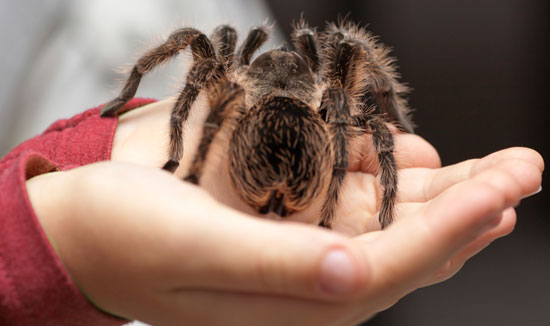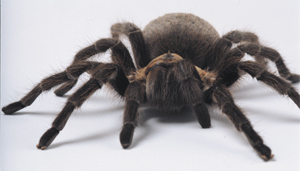How to Keep Spiders as Pets
Spiders can make fascinating pets. Here are a few steps to get you started keeping spiders.

Step 1: Catch a spider
Spiders are all around us, indoors and out, so they’re not hard to find. Some species can bite and a few are venomous. Learn about dangerous spiders in your area before heading out. It’s easy to safely catch a spider by using a small jar. Gently coax it into the jar using the lid. Spiders will eat each other, so keep only one per jar.
Step 2: Prepare a cage
Large spiders do well in the inexpensive plastic terrariums available from pet stores. Smaller ones can be kept in jars or plastic containers if air holes are drilled into the lid or sides. Be sure the holes are small enough to prevent escape.
Potting soil makes good cover for the cage bottom. Sticks, dead leaves or artificial plants provide structure for hiding, climbing and webbing.
Step 3: Water
Depending on the size of the spider, anything from a plastic bottle cap to a small bowl can serve as a water dish. Spiders also drink water sprayed on webbing, but you should never allow the cage to become damp.
Step 4: Feeding
Offer insect prey once or twice a week. Crickets are available from pet shops, or you can collect insects outdoors if no insecticides have been sprayed in the area.
Step 5: Observing
Watch your spider and take notes on its behavior. You won’t believe what happens in the spider’s web until you’ve visited it yourself!
PREFERRED PETS
 Not all spiders do well in captivity. Active hunters are usually easier to keep than web builders. Here are a few that make good pets.
Not all spiders do well in captivity. Active hunters are usually easier to keep than web builders. Here are a few that make good pets.
Tarantulas: Some species exceed 10 inches in legspan. They’re by far the most popular pet spiders and can be bought in pet stores.
Wolf Spiders: Some can be more than three inches in legspan. Large specimens do best in terrariums with lots of floor space.
Jumping Spiders: Although small and rarely exceeding half an inch, their jumping ability is amazing. Many species are brightly colored and can easily be kept in jars.
Fishing Spiders: In captivity, these large spiders appreciate vertically arranged pieces of bark for climbing. They’re very fast, so use caution when capturing them.
Grass Spiders: These spiders build funnel-shaped webs in grass, bushes and on buildings. In captivity, they will build extensive webs inside their cage.
LEARN MORE: Click here to see photos of a spider expert’s seven favorite spiders
Just wanted to mention that really, a dish of water is probably a bad idea, particularly for smaller species. Apart from fishing spiders, which live most of their lives near and partially on the water, spiders can easily get ‘sucked in’ to a pool of water by the surface tension, and drown.
A better water source is a small piece of moist sponge (preferably new, and never one that’s been used with chemicals), a moist cotton ball, or the commercially available ‘water pillows’ used to give water to crickets (you can buy these at petshops, but honestly, sponges are cheaper).
Spiders make fun and fascinating pets (especially jumping spiders; they’ve got a lot of character), and it’d be a real shame to accidentally drown one =(
chuahuaspider953, wolf spiders are not poisonous but they may bite if you make them feel threatened. It needs a cage about 15×30 cm. Hope this helps!
if anyone has any questions on spiders i can answer it
What type of spider do I have? It’s brown, small, and has this dark yellow on its back. I found it hiding under lots of rocks, so how should I make its enclosure? What should I feed it? Keep its water in?
I caught a black spider yesterday but I dont know what kind it is. It is black and about a centimeter.
I just caught a YELLOW SAC SPIDER. It’s going around and around really fast in its plastic container. I love taking care of spiders! 🙂 Thank- you for the information!
-SPIDERGIRL age 4
i have a wolf spider and she is 6 months old. I have upgraded her enclosure 3 times. First one was little coz I didn’t know it was a wolf spider haha. Sheds skin often. Currently 2.5-3 cms atm. Just started getting really distinguished markings which look really tribal. Eating about a cricket a day ???? Not sure if it’s gonna shed another skin or it’s just a glutton hahaha. currently have an enclosure 20×34 and 28-30cms in height. I’m thinking I need to go larger but not sure what size to go to so I won’t have to do it again. Do they borrow ?? or just like leafage to hide under?
Wolf spiders arnt poisoneus and all the spider needs is a small terrarium no smaller than 15cm by 30cm
i hav a steatoda spider that takes care of her egg sac she lives in a jar but theres nothin wrong because there webs are like the sam as black widows and she eats purfectly well and i have a stratagy wen it comes to spider i colect depending on the seasons
i might get one.
Okay I just found out what type of spider it is. It is a wolf spider. But I need help still. I still don’t know if it is poisnus, what sized cage it needs, and now I am worried that it will bite me. If you know any of the questions answers that I am asking please type them right away. Thankyou